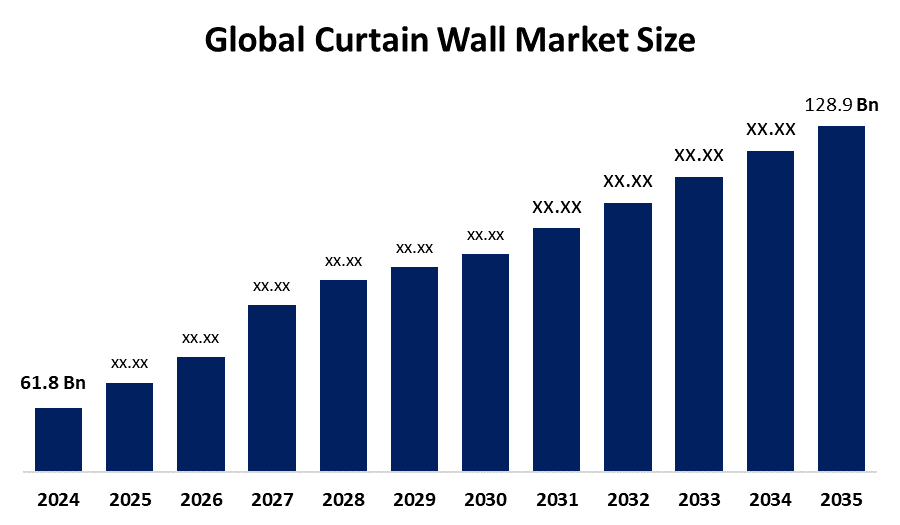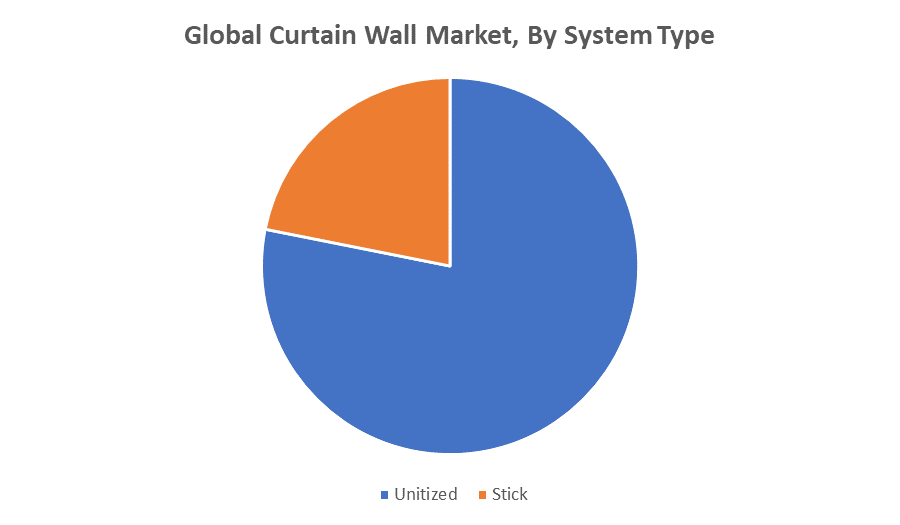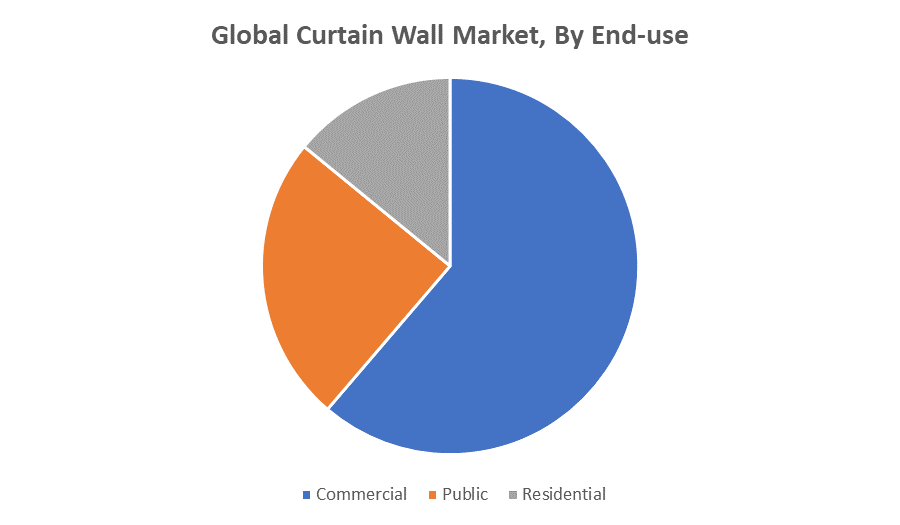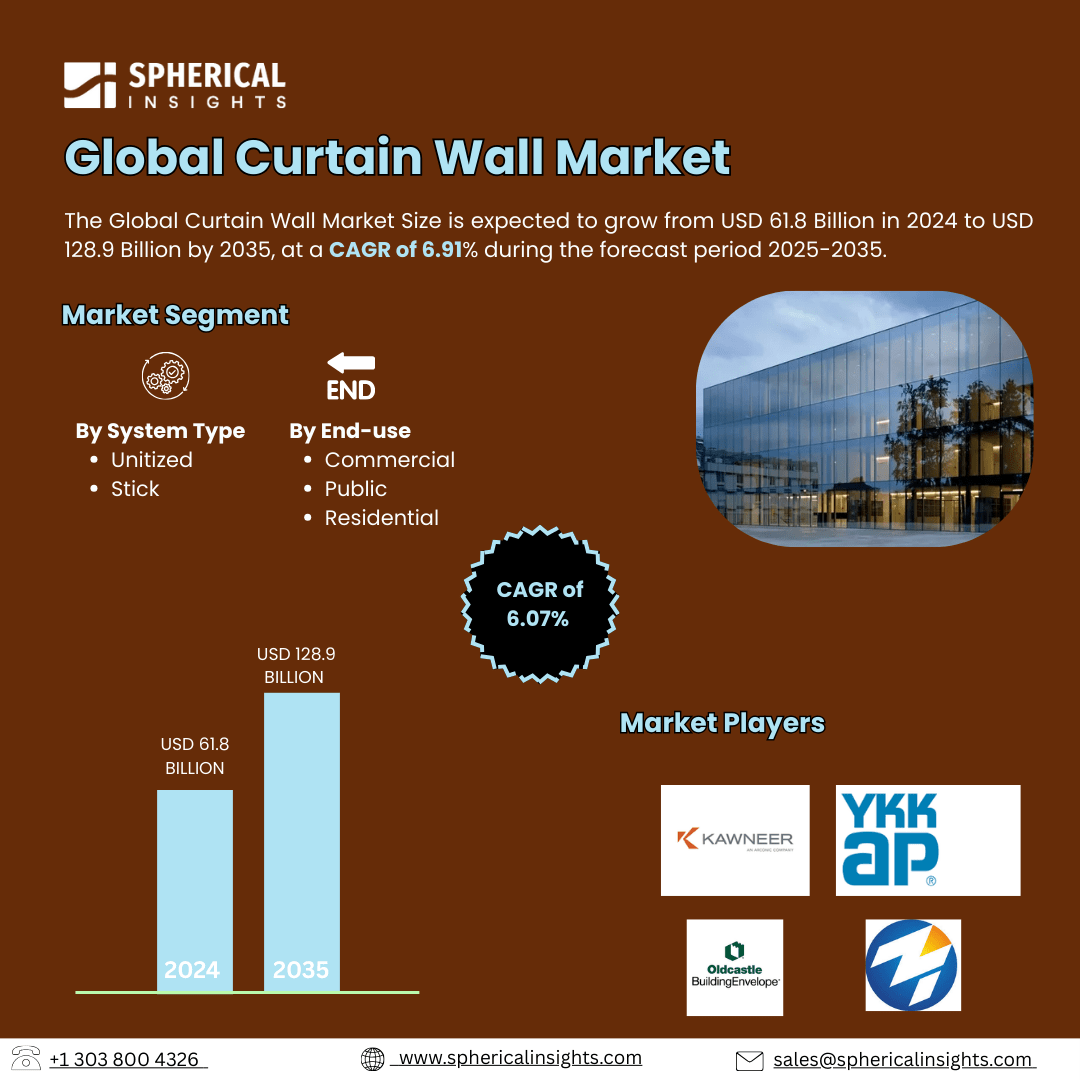Global Curtain Wall Market Insights Forecasts to 2035
- The Global Curtain Wall Market Size Was Estimated at USD 61.8 Billion in 2024
- The Market Size is Expected to Grow at a CAGR of around 6.91% from 2025 to 2035
- The Worldwide Curtain Wall Market Size is Expected to Reach USD 128.9 Billion by 2035
- North America is expected to grow the fastest during the forecast period.

Curtain Wall Market
The global curtain wall market involves the production and installation of non-structural outer coverings for buildings, known as curtain walls. These systems are typically made from materials like glass, aluminum, steel, or composite panels and are designed to protect buildings from external elements such as weather while allowing natural light inside. Unlike load-bearing walls, curtain walls do not support the building’s weight but transfer loads like wind pressure to the main structure. Curtain walls enhance the aesthetic appeal of buildings, providing sleek, modern façades and improving energy efficiency through insulation and light transmission. They are commonly used in commercial, residential, and institutional buildings. The market includes various types of curtain walls, such as stick systems, unitized systems, and structural glazing, each offering different installation and design benefits. Advances in materials and manufacturing have enabled more durable, lightweight, and customizable curtain wall solutions, making them a fundamental feature in contemporary architecture worldwide.
Attractive Opportunities in the Curtain Wall Market
- The rising focus on smart buildings opens up opportunities for curtain wall systems integrated with cutting-edge technologies such as electrochromic (smart) glass and photovoltaic glass. These smart materials allow dynamic control of light, heat, and energy generation, enhancing building efficiency and occupant comfort. This trend drives demand for innovative curtain wall solutions that align with smart, energy-conscious architecture.
- With many cities expanding and modernizing, there is a significant opportunity in upgrading existing buildings through curtain wall retrofitting. Retrofitting projects allow improving energy performance, aesthetics, and sustainability of older structures without complete reconstruction, providing a cost-effective and environmentally friendly way to modernize urban spaces.
- Rapid urbanization and infrastructure development in emerging economies, especially in Asia Pacific, create untapped markets for curtain wall manufacturers. Additionally, the adoption of modular and prefabricated curtain wall systems offers faster installation, cost savings, and reduced construction waste. These factors make modular solutions highly attractive in fast-growing urban regions aiming for sustainable and efficient construction practices.
Global Curtain Wall Market Dynamics
DRIVER: Rapid urbanization and the growth of commercial infrastructure
Rapid urbanization and the growth of commercial infrastructure, including offices, shopping malls, and high-rise buildings, fuel the need for efficient façade systems. Curtain walls contribute to energy efficiency by improving insulation and allowing natural light, aligning with the global emphasis on sustainable and green construction practices. Technological advancements, such as the development of smart glass and improved framing materials, further support market growth by offering enhanced performance and design flexibility. Additionally, stringent building regulations and safety standards push builders to adopt curtain wall systems that provide better weather resistance, fire protection, and structural integrity. Overall, the rising preference for lightweight, durable, and environmentally friendly building solutions continues to propel the curtain wall market forward across various construction sectors worldwide.
RESTRAINT: Maintenance and repair of curtain walls
High initial costs associated with the design, manufacturing, and installation of curtain wall systems can be a significant barrier, especially for small to mid-sized construction projects. The complexity of installation requires skilled labor and specialized equipment, which can increase project timelines and costs. Additionally, maintenance and repair of curtain walls, particularly glass components, can be expensive and challenging over time. Environmental factors such as extreme weather conditions can impact the durability and performance of some curtain wall materials, limiting their use in certain regions. Furthermore, stringent building codes and regulations in some countries may delay project approvals and add to compliance costs. Lastly, competition from alternative façade solutions, such as traditional cladding systems or prefabricated panels, can restrict market expansion by offering lower-cost or simpler options for builders. These challenges collectively pose hurdles to the widespread adoption of curtain wall systems.
OPPORTUNITY: Increasing focus on smart buildings and integration of advanced technologies
The increasing focus on smart buildings and integration of advanced technologies, such as electrochromic and photovoltaic glass, opens new avenues for innovation in curtain wall systems. These smart materials enable dynamic control over light, heat, and energy generation, enhancing building efficiency and occupant comfort. Additionally, the rise in renovation and retrofitting projects in aging urban infrastructures offers significant potential for curtain wall upgrades to improve energy performance and aesthetics. Emerging economies with growing urbanization and infrastructure development present untapped markets for curtain wall manufacturers. The adoption of modular and prefabricated curtain wall solutions also offers opportunities for faster installation, cost savings, and reduced construction waste. Furthermore, growing environmental awareness and stricter sustainability regulations encourage the use of eco-friendly materials and designs, creating a niche for green curtain wall products. These opportunities suggest a promising future for innovation and expansion in the curtain wall market.
CHALLENGES: Market changes fast with new technologies
One big challenge is making sure the curtain walls last a long time and work well in different weather conditions, like very hot or cold climates, heavy rain, or earthquakes. It can be hard to design walls that look good but also save energy and stay safe. Installing curtain walls is also complicated because it needs good teamwork between architects, engineers, and builders, and mistakes can cause delays. Finding good materials that are both strong and environmentally friendly can be tricky, too. Finally, the market changes fast with new technologies, so companies need to keep improving their products while keeping costs under control. These challenges make it harder for curtain wall companies to grow but also push them to come up with better solutions.
Global Curtain Wall Market Ecosystem Analysis
The global curtain wall market ecosystem includes manufacturers supplying materials like glass and aluminum and fabricators who customize these components. Architects and designers integrate curtain walls into building projects while engineers and contractors handle installation. Technology providers contribute innovations such as smart glass and certification bodies ensure quality and compliance. End users including commercial residential and institutional building owners drive demand based on energy efficiency aesthetics and durability needs. Together these players form a connected network supporting the markets growth and innovation worldwide.
Based on the system type, the unitized segment led the glass curtain wall industry and accounted for the largest revenue share over the forecast period

The unitized segment led the glass curtain wall industry and accounted for the largest revenue share over the forecast period. This is because unitized curtain walls are prefabricated in controlled factory settings, allowing for faster installation and better-quality control compared to other systems. Their modular nature reduces on-site labor and construction time, making them ideal for high-rise buildings and large-scale projects. Additionally, unitized systems offer superior performance in terms of weather resistance, thermal insulation, and structural integrity, which drives their popularity and revenue dominance in the market.
Based on the end-use, the commercial segment dominated the market and accounted for the largest revenue share during the forecast period

The commercial segment dominated the market and accounted for the largest revenue share during the forecast period. This is due to the increasing construction of office buildings, shopping malls, hotels, and other commercial spaces that require modern, energy-efficient, and visually appealing façade solutions. Curtain walls in commercial buildings help improve natural lighting and reduce energy costs, making them a preferred choice. The demand for sustainable and innovative building designs in the commercial sector continues to drive the growth and revenue share of this segment in the curtain wall market.
Asia Pacific is anticipated to hold the largest market share of the curtain wall market during the forecast period
Asia Pacific is anticipated to hold the largest market share of the curtain wall market during the forecast period. This growth is driven by rapid urbanization, increasing infrastructure development, and rising investments in commercial and residential construction across countries like China, India, and Southeast Asia. The region’s expanding real estate sector and adoption of modern architectural designs further boost demand for curtain wall systems. Additionally, government initiatives focused on smart cities and sustainable building practices contribute to the growing use of advanced curtain wall technologies in the Asia Pacific market.
North America is expected to grow at the fastest CAGR in the curtain wall market during the forecast period
North America is expected to grow at the fastest CAGR in the curtain wall market during the forecast period. This rapid growth is driven by increasing demand for energy-efficient building envelopes and advancements in façade technologies. Investments in urban infrastructure and the emphasis on sustainable design practices are encouraging the adoption of advanced curtain wall systems, such as double-glazed and low-emissivity glass. Additionally, the integration of modern materials and smart glazing technologies is improving both the performance and aesthetic appeal of buildings, further fueling market expansion across the U.S., Canada, and Mexico.
Recent Development
- In May 2025, Emirates Extrusion Factory and UCS Green Solutions announced an exclusive partnership to produce a Green Curtain Wall System with zero material waste, marking a significant step toward sustainable construction in the UAE.
- In January 2024, TSI Corp. collaborated with Raise Robotics, to install curtain wall brackets using AI-driven robotics, showcasing the integration of smart technologies in curtain wall systems.
Key Market Players
KEY PLAYERS IN THE CURTAIN WALL MARKET INCLUDE
- Kawneer
- Jiangsu Zhongtai Aluminum Co., Ltd.
- YKK AP Inc.
- Oldcastle BuildingEnvelope
- Alcoa Corporation
- Reynaers Aluminium
- Schüco International KG
- Winsa Windows & Doors
- Marmon Group
- Dongkuk Steel Mill Co., Ltd.
Market Segment
This study forecasts revenue at global, regional, and country levels from 2020 to 2035. Spherical Insights has segmented the curtain wall market based on the below-mentioned segments:
Global Curtain Wall Market, By System Type
Global Curtain Wall Market, By End-use
- Commercial
- Public
- Residential
Global Curtain Wall Market, By Regional Analysis
- North America
- Europe
- Germany
- UK
- France
- Italy
- Spain
- Russia
- Rest of Europe
- Asia Pacific
- China
- Japan
- India
- South Korea
- Australia
- Rest of Asia Pacific
- South America
- Brazil
- Argentina
- Rest of South America
- Middle East & Africa
- UAE
- Saudi Arabia
- Qatar
- South Africa
- Rest of the Middle East & Africa






